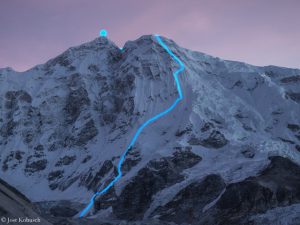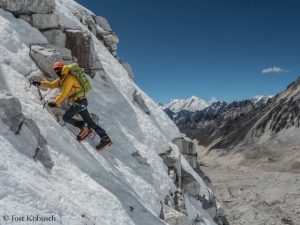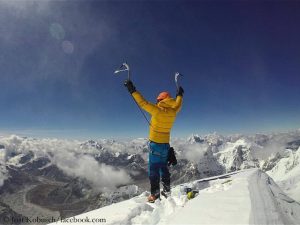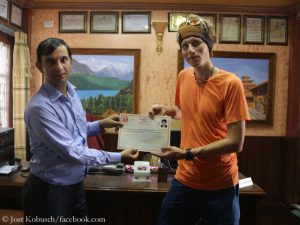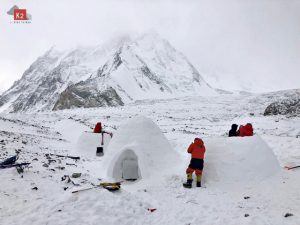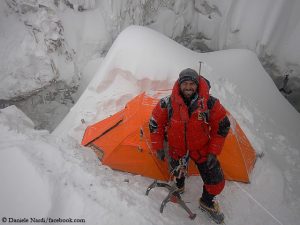Kobusch, first ascender of Nangpai Gosum II: “Very difficult”
“The feeling was more than overwhelming to stand in a place that no one ever entered before me,” writes Jost Kobusch about his first ascent of the 7296-meter-high Nangpai Gosum II in the east of Nepal. As reported, the 25-year-old German had scaled the till then fourth-highest unclimbed mountain on earth two weeks ago. “Such ascents are still pure, real alpinism,” Jost writes to me. “This is exactly the direction I want to take – because a solo on a route with other climbers is not a real solo. I would like to enjoy alpinism in its purest form. For me, this is the maximum of minimalist mountaineering.” In the meantime, Kobusch has also given details of his route, which he graded to me as “TD”, which means “very difficult” (in the International French Adjectival System (IFAS) ,TD stands for “Tres Difficile”, with sustained snow and ice at an angle of 65-80 degrees and rock climbing at grade V and VI). He was en route with a very small team: the Nepali cook Ngima, kitchen helper Phurba and cameraman Raphael Schardt, who, according to Jost, only joined him once on the way to the Advanced Basce Camp (ABC) at the beginning of the expedition, later only filming with a large telephoto lens from the Base Camp.
Near-accident
He had originally planned to ascend via the route through the South Face, where a team of French mountain guides had failed two years in a row, Jost reports. At an altitude of about 6,300 meters, Kobusch nearly fell out of an ice flank. The strong sunlight caused the ice screw and the ice tool, which he had used for belaying at the stand, to be “melted out within 20 minutes”. An “only on the half way hammered in piton” saved his life.
Waist-high snow
Jost descended to the Base Camp and decided to set off for a “light and fast solo” on a different route. After having left the Advanced Base Camp at 5,600 meters and having spent one night in Camp 1 (6,400 meters) and the next in Camp 2 (6,840 meters), he reached the highest point of Nangpai Gosum II on the third day. On the final part of his climb he once again had to clench his teeth, says Jost: “The plateau on top let me struggling through almost waist deep powder to the summit which I reached on 3 Oktober at 10.25 am. Wind speeds of shortly up to 60km/h made my stay at this untouched place short though.” The first ascent of Nangpai Gosum II, Jost writes to me, “is for me personally the beginning of many further expeditions in this style: No support above the base camp, all alone on a route and of course (also on higher mountains) no bottled oxygen.”
Annapurna without bottled oxygen
For the Westphalian Kobusch – born in Bielefeld, where the highest point called “Auf dem Polle” is not a mountain, but a 320-meter-high knoll – it was the second great success of his career as an high-altitude mountaineer. In spring 2016, Jost had scaled his first eight-thousander, Annapurna. A year before, Kobusch had become well known all over the world. The young German had shot a video of the giant avalanche – triggered by the devastating earthquake on 25 April 2015 – which had destroyed the base camp on the Nepali side of Mount Everest and had killed 19 people.



